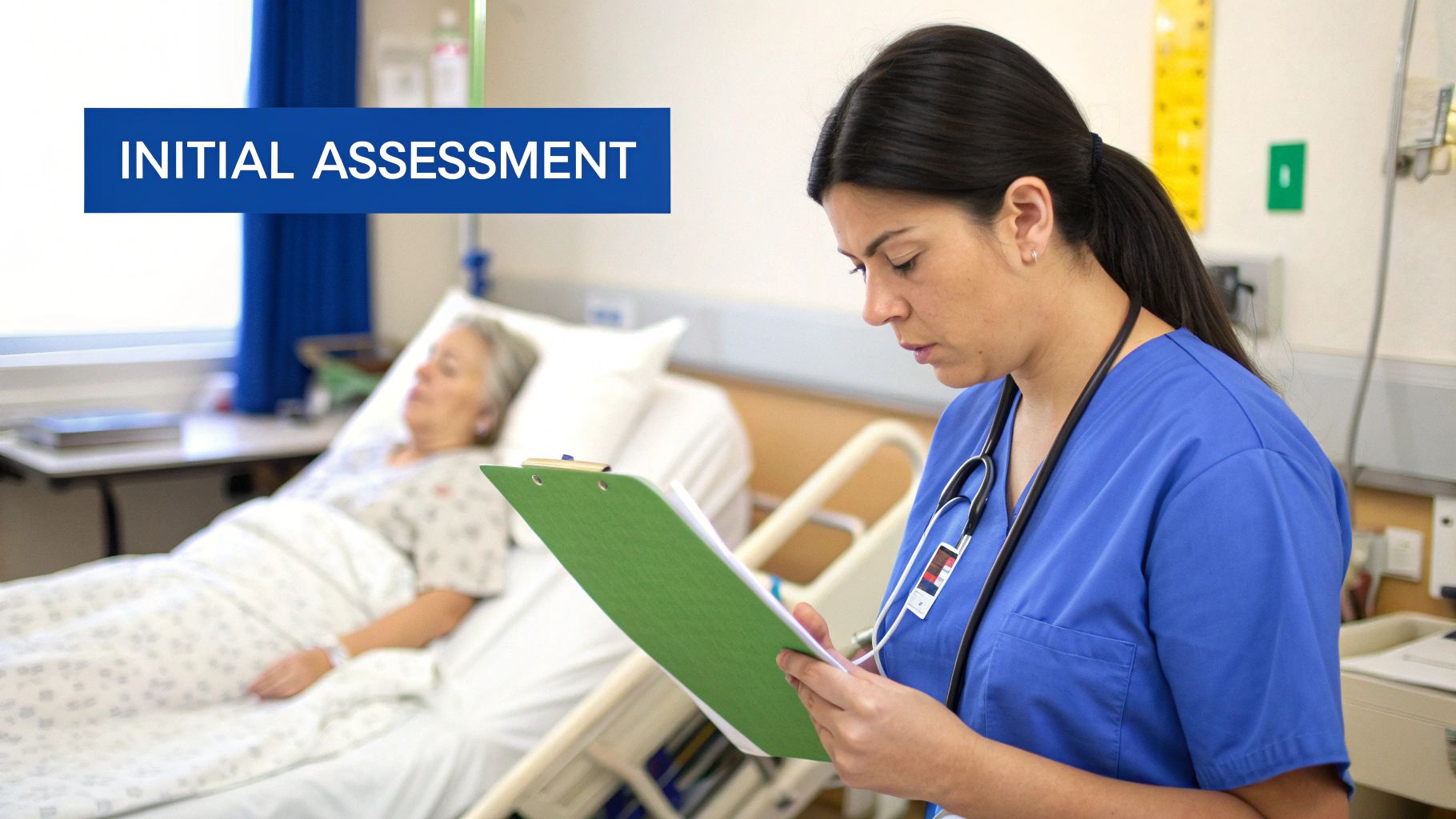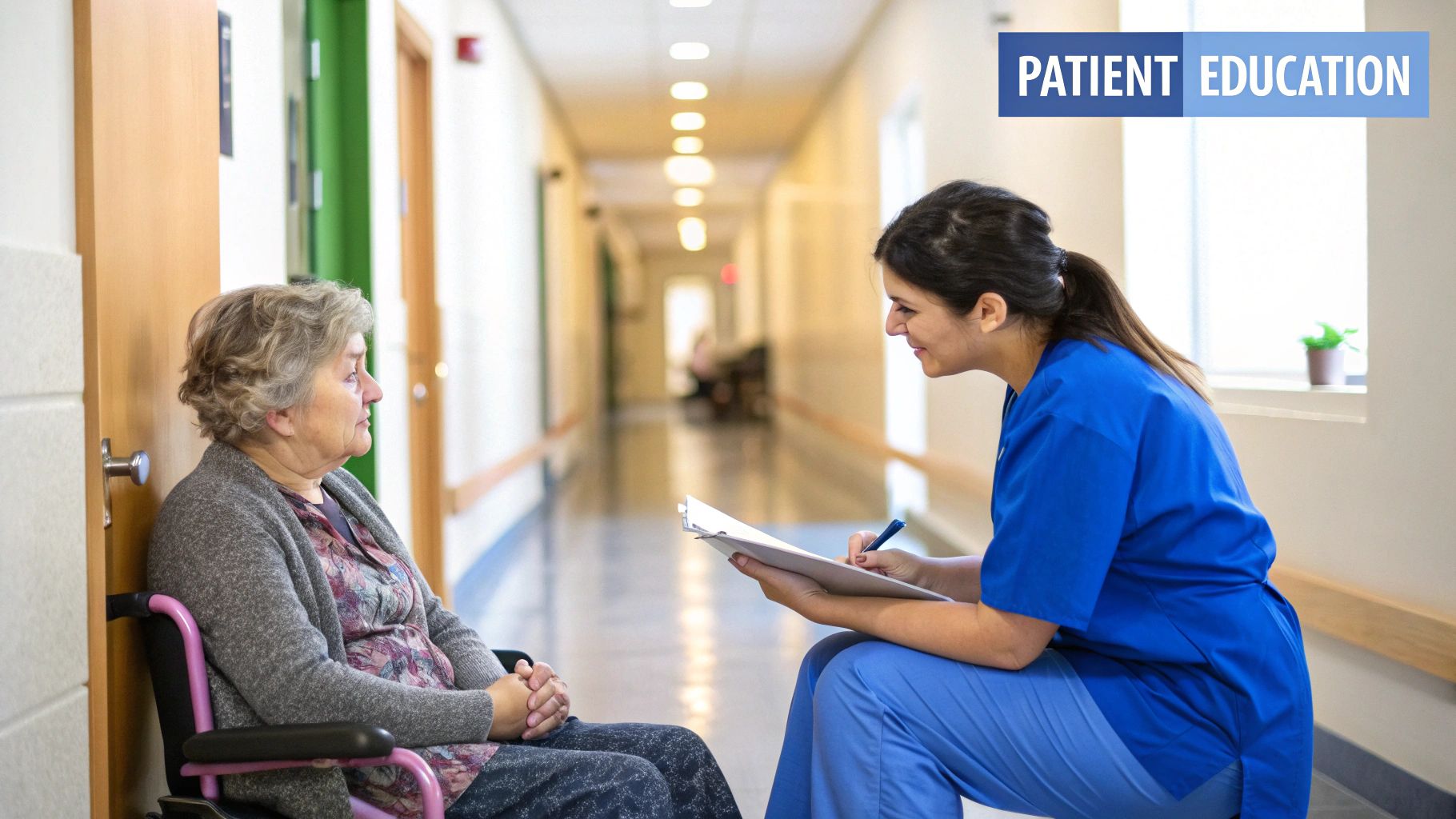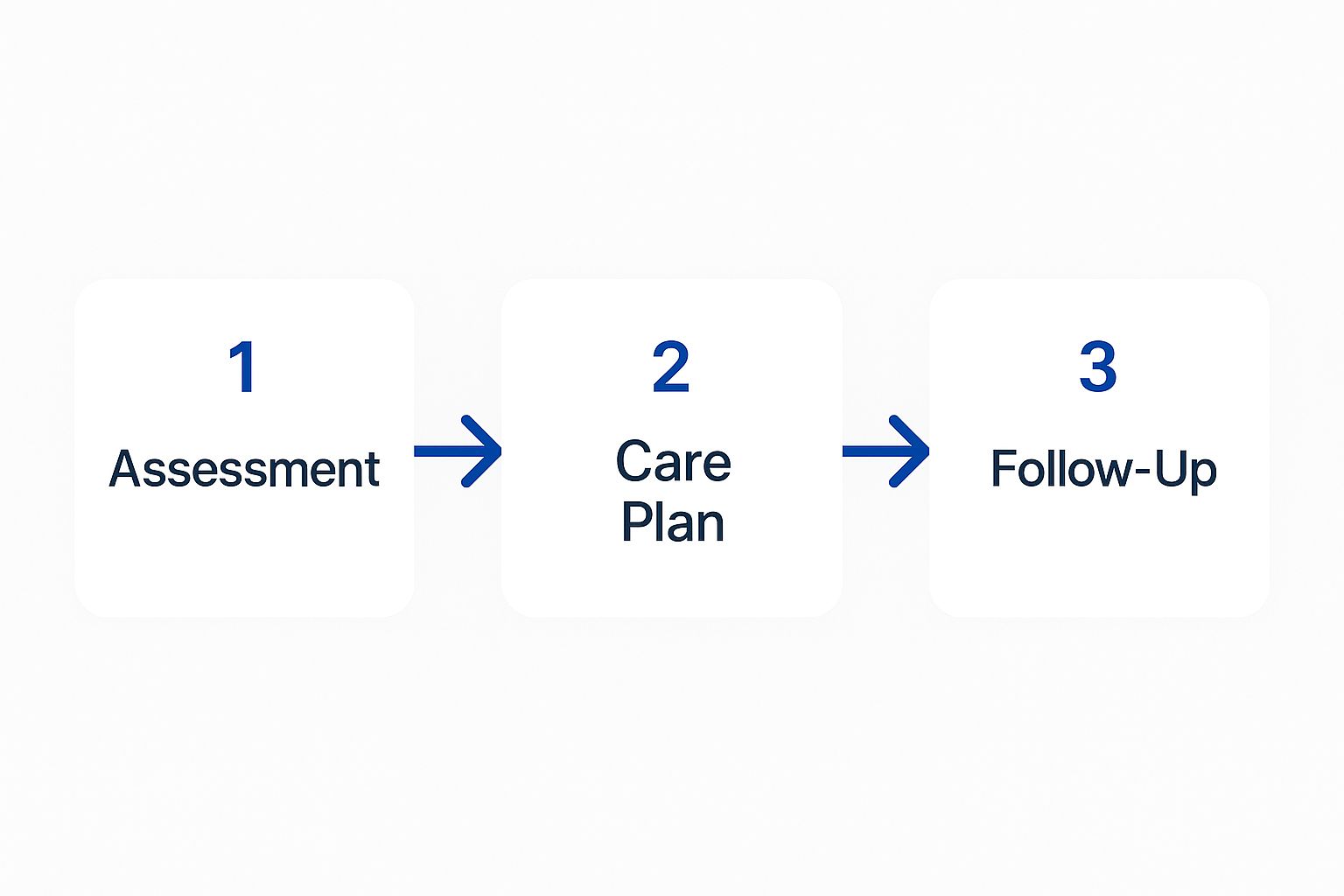What Hospital Discharge Planning Actually Means For Your Family

Many people assume hospital discharge planning is just about grabbing prescriptions and noting a follow-up appointment time. In reality, it’s a detailed blueprint that can make the difference between a smooth recovery at home and a stressful trip back to the emergency room. It's the crucial coordination that connects the supervised environment of a hospital with the practicalities of managing health on your own. The primary aim is to create a safe transition that lowers the risk of readmission and gives families the confidence to manage care.
The impact of good planning is significant. Interestingly, while a solid plan is essential for guiding after-care, it doesn’t necessarily cut the initial hospital stay short. A 2023 study revealed its main advantages were improving hospital bed availability and reducing overall healthcare system costs. This shows its importance for both hospital operations and the patient's long-term well-being. You can discover more about these findings on discharge planning effectiveness.
From Simple to Complex: Understanding Your Discharge Needs
Not all discharge plans look the same. The level of detail and coordination involved is based entirely on the patient's medical condition. Someone leaving after a routine, one-day procedure will have a much simpler plan than a person going home after a three-week ICU stay following a major heart attack. The medical team evaluates a patient's readiness by checking their medical stability, mobility, and capacity for self-care. Any red flags—like unmanaged pain, unstable vitals, or the absence of a safe home environment—can postpone the departure.
Knowing where your loved one fits on this spectrum empowers you to be a better advocate. It helps you understand which questions to ask and what kind of support to push for before leaving the hospital.
Hospital Discharge Planning Scenarios By Complexity
To help you visualize what to expect, let's explore how planning changes based on a patient's recovery needs. This table breaks down different scenarios, from a straightforward recovery to a medically complex transition that demands significant coordination with services like those offered by NJ Caregiving.
| Scenario Type | Planning Timeline | Key Coordination Needs | Family Preparation Level |
|---|---|---|---|
| Simple Recovery (e.g., minor surgery) | Starts 24-48 hours before discharge. | Prescription fulfillment, one follow-up appointment, basic wound care instructions. | Minimal; focus on transportation and comfort at home. |
| Moderate Recovery (e.g., joint replacement) | Begins 3-5 days before discharge. | Physical therapy scheduling, medical equipment delivery (walker), home safety check. | Involved; requires home modifications and managing therapy schedules. |
| Complex Recovery (e.g., stroke, major illness) | Starts soon after admission. | Multiple specialists, in-home nursing, advanced equipment (oxygen), insurance pre-authorizations. | Extensive; requires a deep understanding of the care plan and active family participation. |
As you can see, the more complex the medical situation, the earlier the planning starts and the more involved the family needs to be. For complex cases, preparation is not just helpful—it’s essential for a safe and successful recovery at home.
Assembling Your Healthcare Dream Team
A successful transition from the hospital back home depends on more than just medical stability; it relies on a well-coordinated team of professionals working together. Think of effective hospital discharge planning as putting together a personal healthcare "dream team." This goes beyond just knowing the doctor's name. It's about creating a strong connection with every person involved in the care plan to ensure a smooth handoff from the hospital to your home.
This focus on smooth transitions is a big deal in healthcare. Improving how hospitals work, including the discharge process, is a top concern for health systems everywhere. A 2024 Deloitte survey of top executives revealed that over 70% see these improvements as a major priority for 2025. It’s clear that getting this right is important for everyone, from hospital leadership to the families waiting at the bedside. You can read the full executive outlook on global health care priorities to learn more.
Your Key Players and How to Engage Them
Your team is much bigger than just the attending physician. Each member has a specific role, and knowing how to communicate with them is crucial for a safe return home.
- Case Manager or Discharge Planner: This person is your main coordinator and the central point for setting up services like home health aides and medical equipment. Tip: Ask them directly, “What is the biggest potential roadblock you see for our transition, and how can we get ahead of it?”
- Floor Nurses: Nurses are your on-the-ground support, especially across different shifts. They see the day-to-day progress and challenges of recovery. Tip: When a new nurse starts their shift, introduce yourself and ask, “Is there anything you’ve noticed today that we should add to our discharge notes?”
- Pharmacist: Don't just pick up the prescriptions; have a conversation with the hospital pharmacist. They can explain side effects and possible drug interactions in simple terms. Tip: Ask, “Can you walk me through the most critical medication on this list and what to do if we miss a dose?”
- Therapists (Physical/Occupational): These experts are the ones who figure out what safe movement and daily activities will look like at home. Tip: Ask them for specific demonstrations of any exercises or tasks your loved one will need to do on their own.
Documenting Everything for a Safer Transition
Miscommunication often happens during shift changes or over a busy weekend. The solution? Create your own paper trail. A simple notebook can become your most powerful tool. After every important conversation, write down the date, the person’s name, and the key information or decisions that were made.
This personal record ensures everyone is on the same page and helps hold the team accountable. For instance, if a physical therapist recommends a specific type of walker, having it written down prevents confusion when the case manager goes to order the equipment. This simple act of diligence turns you from a bystander into an active, informed manager of the discharge process. You might also find our visual guide to caregiving essentials helpful.
Transforming Your Home Into A Recovery Haven

A key part of a successful hospital discharge plan is getting the home ready for a safe return. Your house is about to become a place of healing, but that doesn't mean it needs to look and feel like a hospital room. The idea is to make smart, practical adjustments that boost safety without sacrificing the comfort and dignity of a familiar living space. Even small changes can dramatically lower the risk of accidents and create a setting that truly helps with recuperation.
This preparation should ideally start before your loved one comes home. Take a walk through the main areas they'll be using—think about the path from the front door to the bedroom and then to the bathroom. Keep an eye out for potential tripping hazards like loose area rugs, tangled electrical cords, or general clutter. A clear path is a safe path, and this simple step can help prevent falls, which are a leading cause of hospital readmission for seniors.
Setting Up Key Recovery Zones
Instead of trying to remake the entire house, concentrate your efforts on the two most critical areas: the bedroom and the bathroom. These are the rooms where your loved one will likely spend the most time and where safety is absolutely essential.
The Bedroom:
- Create a "Command Center": If stairs are a potential problem, think about moving the bed to the main floor. Set up a bedside table with everything they might need close at hand: a water bottle, medications, the TV remote, a phone, and tissues. This simple setup gives them a sense of independence and cuts down on unnecessary trips out of bed.
- Brighten Things Up: Make sure there's a bright, easy-to-operate lamp right by the bed. Adding a few nightlights along the hallway to the bathroom is also a great idea. Good lighting is vital for preventing trips and falls, particularly during the night.
The Bathroom:
- Focus on Stability: The bathroom can be one of the riskiest rooms in the house. Installing grab bars in the shower and next to the toilet is a non-negotiable safety upgrade. For someone with serious mobility issues, a shower chair and a raised toilet seat can provide much-needed stability and confidence.
- Prevent Slips and Slides: Place a non-slip mat both inside the tub or shower and on the floor outside of it. This is a very inexpensive fix that provides a huge safety benefit.
To help you plan, here’s a look at common modifications based on different recovery needs.
| Recovery Focus | Critical Modifications | Approximate Investment | Professional vs DIY |
|---|---|---|---|
| General Mobility/Fall Risk | Grab bars in bathroom, non-slip mats, clear pathways, improved lighting, stairlift (if needed). | $150 – $5,000+ | Many items like mats and nightlights are DIY. Grab bars and stairlifts require professional installation for safety. |
| Post-Orthopedic Surgery (Hip/Knee) | Raised toilet seat, shower chair, walker/crutches access, removal of throw rugs. | $100 – $400 | Mostly DIY setup, but ensure all equipment is assembled correctly according to instructions. |
| Post-Stroke Recovery | Hospital bed, grab bars, wheelchair ramp, removal of thresholds, handheld shower head. | $500 – $8,000+ | Ramps and major modifications need a professional. Bed and bathroom aids can be set up by family. |
| Post-Cardiac Event | Bedside commode (to reduce exertion), organize essentials on one floor, heart rate monitor nearby. | $50 – $250 | All DIY. The focus is on reducing physical strain through strategic placement of items. |
These modifications are a practical way to show support and contribute to a smoother, safer recovery at home.
When you can't make permanent changes, like in a rental apartment, you can still find effective solutions. For instance, pressure-mounted grab bars can be installed without drilling holes, and furniture can be rearranged to open up wider, safer walkways. The trick is to think like an occupational therapist: look at the environment, spot the risks, and put practical solutions in place that make daily life easier and safer.
Mastering Medications And Medical Equipment At Home
Coming home with a bag full of new prescriptions and maybe an intimidating piece of medical equipment can feel like a lot to handle. This is often the most hands-on part of any **hospital discharge planning**, and it’s where many families feel the most pressure. Let’s walk through how you can manage these new responsibilities with confidence.
Taming The Pill Bottle Chaos
A complicated medication schedule can get confusing fast, especially when you’re already tired from the transition. Medication mistakes are a major reason people end up back in the hospital, so getting this part right is incredibly important.
- Create a Master List: Before you even leave the hospital, ask for a complete, printed list of all medications. For each one, make sure you understand the name, dose, what time it should be taken, and what it’s for.
- Use Organization Tools: A simple weekly pill organizer is a fantastic start. For more complex routines, think about an automated pill dispenser that sends an alert when it's time for a dose. You can also use smartphone apps like Medisafe or CareZone that send reminders to multiple family members.
- Build a Pharmacy Relationship: Your local pharmacist is one of your best resources. Ask them about bubble packing services, where they pre-package doses by date and time. This can be a real lifesaver and helps avoid last-minute refill scrambles.
Demystifying Medical Equipment
Bringing home equipment like an oxygen concentrator or wound care supplies might feel like a huge challenge. The most important thing is to demand proper training before you leave the hospital. Don’t let the staff rush you. Have the nurse or respiratory therapist walk you through every single step—how to use it, clean it, and handle common problems.
A great tip is to record a video of the demonstration on your phone so you can watch it later. Even better, practice using the equipment yourself while the professional is there to watch. It's one thing to see an expert do it; it's another thing entirely to manage it on your own at 2 AM.
It's a fact that unclear discharge instructions are a huge problem. For instance, 28.3% of readmitted heart failure patients said they didn't fully understand their instructions. This really highlights why getting hands-on practice is so vital. When you feel confident, you can provide much better care. For a helpful visual, you can download our quick reference guide on caregiving essentials.
Cracking The Insurance Code For Maximum Coverage

Let’s be honest: talking about insurance is rarely fun, but it's one of the most important conversations you’ll have during the hospital discharge planning process. Getting a handle on your coverage can literally save you thousands of dollars and prevent a world of stress. Knowing what your plan covers for post-hospital care—and what it doesn't—is the key to a financially stable recovery.
Medicare vs. Private Insurance: Key Differences
When it comes to paying for care after a hospital stay, you'll quickly find that not all insurance plans are created equal. You need to know exactly what kind of services are on the table before making any decisions.
- Medicare: It typically covers short-term stays in a Skilled Nursing Facility (SNF), but only if you had a qualifying hospital stay of at least three days first. Home health care might also be covered, but this usually requires that the patient is considered "homebound" and needs skilled medical services.
- Private Insurance: Coverage varies wildly from one plan to the next. Some offer generous home health benefits, while others might have steep deductibles or demand strict pre-authorizations for things like physical therapy. The single most important thing you can do is call your insurance provider directly and ask for a detailed breakdown of benefits specifically for post-discharge care.
Insider Strategies For Maximizing Your Benefits
Don't just take the first "no" you hear from an insurance company as the final word. A little persistence can often unlock coverage you didn't realize you had. If a claim is denied, your first move should always be to get the denial in writing. This document will list the specific reason for their decision, which is crucial for your next steps.
Work closely with the hospital's case manager to file an appeal. They navigate these situations daily and can help you gather the necessary medical documents to build a strong case. This is where larger healthcare policies truly make a difference for patients. Initiatives from the Affordable Care Act, for instance, have pushed hospitals to improve their discharge processes to avoid readmissions.
In fact, a 2024 Commonwealth Fund report confirmed that these focused policies have successfully lowered readmissions across ten countries. To see how these initiatives improve care for older adults, you can learn more about the international survey findings. Staying informed and being persistent gives you the best shot at getting the coverage you need.
Building Your Recovery Support Network That Actually Works
The first few weeks after a hospital stay are a crucial recovery period. A strong support system is one of the most powerful tools in your hospital discharge planning toolbox. This isn't just about having people around; it's about building a team that understands your real-life situation and helps prevent the complications that could send you back to the hospital. A smart support plan balances medical needs with the practical side of recovery, like dealing with low energy and figuring out transportation.
This means being realistic about what you or your loved one can handle. For example, a calendar packed with three different specialist appointments in a single week might seem productive, but it can be exhausting for someone who is still healing. A much better approach is to coordinate with the care team to prioritize appointments. Tackle the most urgent ones first and schedule the others to allow for plenty of rest in between.
Crafting Your Circle of Support
Putting together this network means looking beyond your immediate family. You're assembling a team where different people can help in different ways, from picking up prescriptions to just being there for a chat.
- Family and Friends: Be specific when you ask for help. Instead of a general, "I could use some help next week," try something concrete like, "Could you drive me to my physical therapy appointment on Tuesday at 10 AM?" This clarity makes it much easier for people to step in and provide meaningful assistance.
- Professional Caregivers: When hands-on support like personal care or medication reminders is needed, a professional from an agency like NJ Caregiving can be an essential part of the team. They offer skilled care that takes the pressure off family members. Our visual on caregiving essentials can be a useful guide here.
- Community and Volunteer Groups: Don't forget to check local resources. Many communities have volunteer driver programs or meal delivery services created specifically for seniors. These programs can be lifesavers, filling in important gaps in the care plan.
Accepting Help While Staying Independent
One of the toughest emotional challenges during recovery can be the feeling of losing independence. It’s hard to go from managing everything yourself to needing help with daily tasks. The key is to reframe this support not as a loss, but as a temporary bridge to getting back on your feet.
Think of it like a construction project: you need scaffolding to build something strong and stable. Your support network is that scaffolding. By gracefully accepting help for things like meal prep or rides to the doctor, you conserve your limited energy for the most important job—healing. Communicating your needs clearly while setting boundaries helps you stay in control. This team approach makes the entire process of recovering at home feel less like a burden and more like a shared goal.
Your Complete Discharge Success Action Plan
Bringing all the moving parts of hospital discharge planning together can feel overwhelming, but it doesn't have to be. Let's build a clear, practical action plan to guide you. Think of this less as a strict set of rules and more as a flexible roadmap to build your confidence for the transition home. It’s all about setting small, achievable goals, knowing who to call for help, and having a backup plan for the unexpected bumps in the road to recovery.
A smooth transition home is typically built on three key stages: a thorough assessment of needs, a detailed care plan, and consistent follow-up. This structure helps ensure that no crucial details get overlooked.
This visual helps show how each step flows into the next.

As you can see, the process is logical. It starts with understanding what your loved one needs, moves into creating a specific plan to meet those needs, and wraps up with the vital after-care that helps prevent readmissions and setbacks. It turns a potentially chaotic time into a more manageable journey.
Your Post-Discharge Checklist
To put this into action, let's walk through a checklist to help you navigate the first few weeks back at home. The goal here is to celebrate the small victories while keeping a close eye on any potential warning signs.
First 24-48 Hours Home:
- Medication Review: The first thing to do is lay out all the new prescriptions. Carefully match them against the written discharge papers from the hospital. A pill organizer is your best friend here—use one to set up the first week's doses right away.
- Comfort & Safety: Make sure the main recovery spot is both comfortable and safe. Are the phone, water, and TV remote all within easy reach? Small adjustments can make a big difference.
- Initial Check-In: You should expect a call from either the hospital discharge planner or the home health agency. This is your first opportunity to ask any immediate questions that have popped up since arriving home.
First Week Home:
- Follow-Up Appointments: Go through the discharge papers and confirm the dates and times for all upcoming appointments. If getting there is a problem, now is the time to arrange for transportation. It's a critical step; research shows that patients who miss follow-ups due to a lack of transportation have a 29.1% readmission rate.
- Monitor for Red Flags: Keep a simple notebook or a note on your phone to track symptoms. Be watchful for the specific warning signs the doctor mentioned, such as a sudden fever, increased pain, or new swelling.
- Celebrate a Milestone: Don't underestimate the power of positive reinforcement. Acknowledging a full week back at home or the first time your loved one manages a small task on their own can be a fantastic morale booster for everyone.
This plan is all about being prepared yet ready to adapt. When challenges pop up—and they often do—having a clear strategy and the right people to call on makes all the difference.
For families in Mercer County who want an extra layer of professional support to bring this plan to life, NJ Caregiving offers compassionate in-home assistance. We're here to help ensure a recovery that is both safe and dignified. Learn more about how our skilled caregivers can support your transition home.


